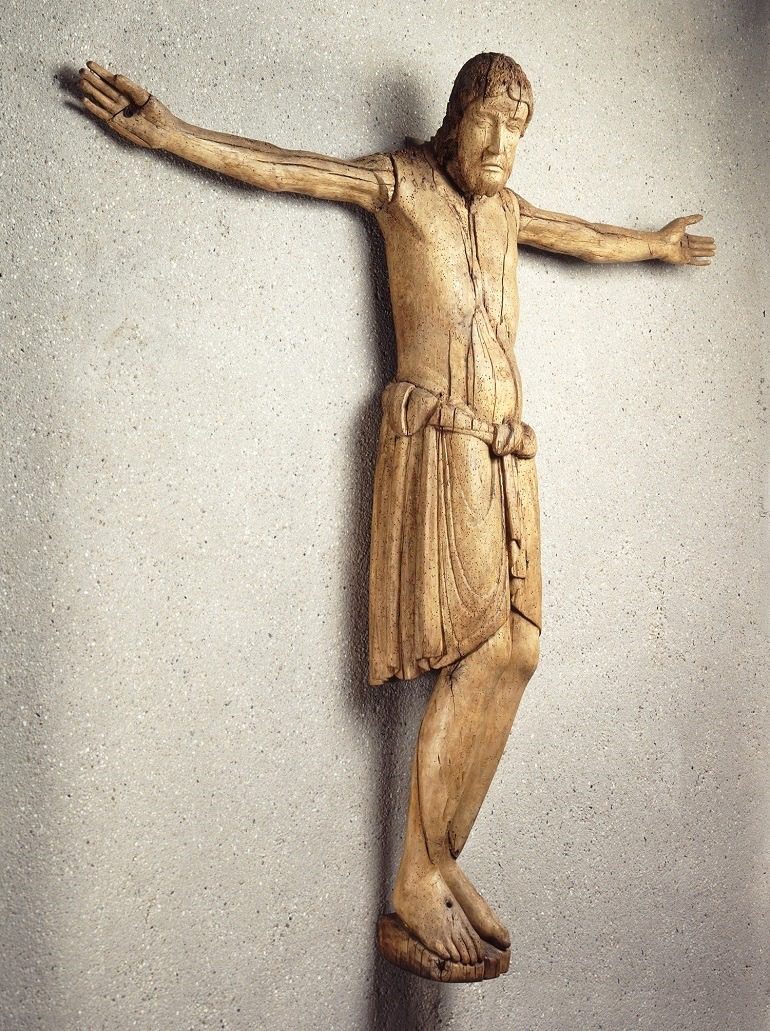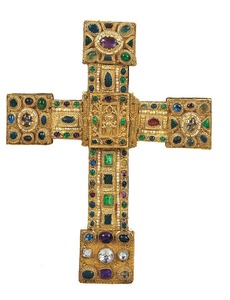ART NEWS
Gospel Lectionary and Collectar, German (Reichenau), ca,. 1010–30, one of the Medieval Treasures from Hildesheim. Tempera and gold on vellum Overall 8–3/4 × 6–1/2 in. (22 × 16.5 cm); 96 leaves. Dombibliothek Hildesheim (Hs. 688). Image courtesy of The Metropolitan Museum of Art
ART REVIEW: God, church, faith, and Jesus Christ celebrated in Medieval Treasures from Hildesheim.
BY KAZAD

Ringelheim Crucifix German (Hildesheim), ca. 1000 / before 1022, Linden wood (corpus) and oak (arms) Overall 63–7/8 × 63–3/8 × 9–7/8 in. (162 × 161 × 25 cm). Image courtesy of The Metropolitan Museum of Art

Hezilo Cross, German (Hildesheim), before 1079. Gold, copper, pearls, and gems; wood core covered in silk, 9–5/8 x 7–5/8 x 1–1/4 in. (24.3 x 19.2 x 3.2 cm). Image courtesy of The Metropolitan Museum of Art
NEW YORK, NY., – Gold, silver, and other valuable gemstones are at the center of Medieval Treasures from Hildesheim, an extraordinary exhibition going on at the Metropolitan Museum of Art. The exhibition, which is located in the center of the museum, features 50 medieval church treasures from Germany’s Hildesheim Cathedral in Lower Saxony. Most of these treasures have never been shown outside Europe.
In the high middle ages, Hildesheim in northern Germany was the center of bronze-making and other artistic activities. Craftsmen and artisans coverage there to display their creative talents and also make money. Because there were lots of churches in Hildesheim, patronage came mainly from the churches. Consequently, many of the works created by the craftspeople were religious.
The artworks celebrate the glory of God and the power of Kings. With the unprecedented patronage, Hildesheim soon developed into a top-class art industry and creativity flourished. From metal-casting workshops and scriptoria came amazing art pieces, ranging from sculptures to books and religious treasures, lavishly decorated with gemstones.
Of all the churches in Hildesheim, Hildesheim Cathedral was the most outstanding in patronage and stature. Over time, the collection grew and the Cathedral now has one of the most complete surviving ensembles of church furnishings and treasures in Europe, with many masterpieces made between 1000 and 1250. Some of the treasures include precious religious art, sculptures, illuminated books, and other religious paraphernalia.
In 1985, Hildesheim Cathedral was designated a UNESCO World Cultural Heritage Site for its outstanding collection of treasures. Many of the treasures presently on display at the Metropolitan Museum of Art came from the Hildesheim Cathedral. They were sent to the Met because of an on-going renovation at the Hildesheim Cathedral.
That many of these artifacts have survived till now is somewhat of a miracle. From the 16th through the 19th century, the treasures went through many dark moments, the most significant of which happened toward the end of World War II, when it was bombed and leveled. They were also the subject of religious power struggles and war.
Although many of these religious arts were created for religious ceremonies and daily religious activities, they also have great values. Medieval Treasures from Hildesheim consists of opulent jeweled crosses, as well as reliquaries and portable altars decorated with enamel, ivory, precious metals, and gemstones. Like the treasures from the Hildesheim Cathedral, many of the religious art from Hildesheim continue to be preserved in museums and churches.
Like many works created by artisans and craftspeople during this period, many of the works are not signed, and cannot be attributed to any artist. What is, however, well documented is the name of the man who commissioned many of them: Bishop Bernward of Hildesheim.
Bernward was the bishop of Hildesheim from A.D. 993 to 1022. He was highly revered not just because of his position as a noble cleric, but also because of his judicial powers and involvement in cultural activities of everyday life. Bernward, a canonized saint, was also a great art patron and he commissioned many religious arts, some of which are on display in Medieval Treasures from Hildesheim.
There are many outstanding works in this exhibition. One of the very impressive and raveling pieces in the show is the Golden Madonna, a statue of the Virgin and Child. The ravages of age, use, and perilous time are glaring on this piece. Both figures making up this composition have lost their heads. Although they were complete with heads when they were created, both heads are now long gone.
Church documents show that the Golden Madonna was a point of attraction during the 15th century. Worshippers buried the statue in brooches, necklaces, and rings offered in exchange for God’s blessings. Even without its heads, this is a magnificent statue. The glazed surface, beautifully decorated with various gemstones, is gorgeous and captivating.
The monumental life-size wood carving known as the Ringelheim crucifix is another great work. It is outstanding in the true sense of the word. Located in the gallery containing one of the most impressive groups of 11th-century works of art ever seen in North America, the carving is one of the earliest surviving three-dimensional sculptures of the Middle Ages.
At five-foot-tall, the figure of the crucified Jesus brings context to all the treasures as religious artifacts. Commissioned by Bernward for the convent of Ringelheim, the carving is installed high in the gallery to give it prominence and also gain maximum attention.
Although this carving of Jesus has lost its color and the cross that amplified his suffering, it is impossible to overlook this monumental sculpture. Even devoid of the luster of early years, the expression on the face of Jesus reveals the gruesome events, including the horrific beating of his last days. His swollen eyes, scarred face, and broken lips are sufficiently depicted to reveal the agony and fear of the dying Jesus.
In the Medieval Sculpture Hall is the famous Hildesheim cathedral’s monumental bronze baptismal font dating to about 1226. This is one of the most important works to survive from the Middle Ages. Measuring six feet in height, this famous richly decorated baptismal font is a sight to behold. On the basin is a relief that depicts the Baptism of Christ and the Virgin Enthroned flanked by scenes from the Hebrew Bible that were understood in the Middle Ages to foreshadow the Baptism of Christ. Complementing the relief on the basin are four additional scenes in relief, and ancillary figures and lengthy inscriptions beautifully rendered on the lid. The basin and its lid gracefully rest on free-standing kneeling figures of the Four Rivers of Paradise that were delicately finished.
Also on view in the exhibition are other important examples of bronze work from that time. They include a cast bronze eagle lectern, a lion aquamanile, a crozier (a religious staff of office, in the shape of a shepherd’s crook), a Silver crucifix, a pair of richly decorated silver candlesticks, sumptuously illuminated manuscripts, and many smaller precious works of art commissioned by Bernward mostly for his Benedictine monastic foundation.
Medieval Treasures from Hildesheim is a show with amazing treasures. The exhibition provides an opportunity for those who cannot travel to Germany to experience the treasure first hand. Sadly, not all of Bishop Bernward of Hildesheim commissions made it to the Met for this exhibition. A set of enormous bronze doors and the column still reside in Germany. The doors which are covered with narrative relief were commissioned by Bernward for the Benedictine church of St. Michael in Hildesheim Cathedral.
Organized by Peter Barnet, the Met’s senior curator of medieval art, and Michael Brandt and Gerhard Lutz of the Hildesheim Cathedral Museum, this is an exhibition that everyone must-see. Although these are religious treasures, they are also historical art pieces. They tell stories of religion, power, beauty, and the experience of the middle ages in Hildesheim. The Medieval Treasures from Hildesheim also highlights stories of how art was effectively used to shape religion, and how those encounters continue to shape the understanding of the relationship between art and religion.

Baptismal Font, German (Hildesheim), ca. 1226. Copper alloy, cast in eight pieces. Overall H. ca. 72–7/8 in. (185 cm); font: H. 26–3/8 in. (67 cm); Diam. 37–3/4 in. 95.9 cm.); cover H. 16–1/8 in. (41 cm); finial: H. 12–5/8 in. (32 cm); supporting figures: H. 18–1/2 in. to 19–3/4 in. (47 cm to 50cm). Image courtesy of The Metropolitan Museum of Art
Join the art conversation: Share your thoughts and comments. FOLLOW US ON: Facebook– Twitter–Google+
